Design of 400 V Miniature DC Solid State Circuit Breaker with SiC MOSFET
Abstract
:1. Introduction
2. Topology of the SSCB with SiC MOSFET
3. Design of the SSCB with SiC MOSFET
3.1. Device Selection
3.2. Drive Circuit
3.2.1. Gate Voltage
3.2.2. Gate Resistance
3.2.3. Driver Chip
3.3. Fault Detection Circuit
3.4. Design of the Energy Absorption Circuit
3.5. Design of the Snubber Circuit
4. Testing on the SSCB Prototype with SiC MOSFET
5. Conclusions
Author Contributions
Funding
Conflicts of Interest
References
- Bifaretti, S.; Zanchetta, P.; Watson, A.; Tarisciotti, L.; Clare, J.C. Advanced Power Electronic Conversion and Control System for Universal and Flexible Power Management. IEEE Trans. Smart Grid 2011, 2, 231–243. [Google Scholar] [CrossRef]
- Dragičević, T.; Lu, X.; Vasquez, J.C.; Guerrero, J.M. DC Microgrids—Part II: A Review of Power Architectures, Applications, and Standardization Issues. IEEE Trans. Power Electron. 2016, 31, 3528–3549. [Google Scholar] [CrossRef] [Green Version]
- Yang, J.; Fletcher, J.E.; O’Reilly, J. Short-Circuit and Ground Fault Analyses and Location in VSC-Based DC Network Cables. IEEE Trans. Ind. Electron. 2012, 59, 3827–3837. [Google Scholar] [CrossRef] [Green Version]
- Salomonsson, D.; Soder, L.; Sannino, A. Protection of Low-Voltage DC Microgrids. IEEE Trans. Power Deliv. 2009, 24, 1045–1053. [Google Scholar] [CrossRef]
- Munasib, S.; Balda, J.C. Short-circuit protection for low-voltage DC microgrids based on solid-state circuit breakers. In Proceedings of the 2016 IEEE 7th International Symposium on Power Electronics for Distributed Generation Systems (PEDG), Vancouver, BC, Canada, 27–30 June 2016; IEEE: Piscataway, NJ, USA, 2016; pp. 1–7. [Google Scholar]
- Shukla, A.; Demetriades, G.D. A Survey on Hybrid Circuit-Breaker Topologies. IEEE Trans. Power Deliv. 2015, 30, 627–641. [Google Scholar] [CrossRef]
- Meyer, J.-M.; Rufer, A. A DC Hybrid Circuit Breaker with Ultra-Fast Contact Opening and Integrated Gate-Commutated Thyristors (IGCTs). IEEE Trans. Power Deliv. 2006, 21, 646–651. [Google Scholar] [CrossRef]
- Franck, C.M. HVDC Circuit Breakers: A Review Identifying Future Research Needs. IEEE Trans. Power Deliv. 2011, 26, 998–1007. [Google Scholar] [CrossRef] [Green Version]
- Kempkes, M.; Roth, I.; Gaudreau, M. Solid-state circuit breakers for Medium Voltage DC power. In Proceedings of the 2011 IEEE Electric Ship Technologies Symposium, Alexandria, VA, USA, 10–13 April 2011; IEEE: Piscataway, NJ, USA, 2011; pp. 254–257. [Google Scholar]
- Shen, Z.J.; Miao, Z.; Roshandeh, A.M. Solid state circuit breakers for DC micrgrids: Current status and future trends. In Proceedings of the 2015 IEEE First International Conference on DC Microgrids (ICDCM), Atlanta, GA, USA, 7–10 June 2015; IEEE: Piscataway, NJ, USA, 2015; pp. 228–233. [Google Scholar]
- Sano, K.; Takasaki, M. A Surgeless Solid-State DC Circuit Breaker for Voltage-Source-Converter-Based HVDC Systems. IEEE Trans. Ind. Appl. 2014, 50, 2690–2699. [Google Scholar] [CrossRef]
- Schmerda, R.; Cuzner, R.; Clark, R.; Nowak, D.; Bunzel, S. Shipboard Solid-State Protection: Overview and Applications. IEEE Electr. Mag. 2013, 1, 32–39. [Google Scholar] [CrossRef]
- Schmitt, S. MOSFET Selection and Drive Strategies for DC Solid State Circuit Breakers. In Proceedings of the PCIM Europe 2014; International Exhibition and Conference for Power Electronics, Intelligent Motion, Renewable Energy and Energy Management, Nuremberg, Germany, 20–22 May 2014; IEEE: Piscataway, NJ, USA, 2014; pp. 1–6. [Google Scholar]
- Vemulapati, U.; Arnold, M.; Rahimo, M.; Antoniazzi, A.; Pessina, D. Reverse blocking IGCT optimised for 1 kV DC bi-directional solid state circuit breaker. IET Power Electron. 2015, 8, 2308–2314. [Google Scholar] [CrossRef]
- Takayanagi, R.; Taniguchi, K.; Kaneko, S.; Kanai, N.; Kumada, K.; Hori, M.; Ikeda, Y.; Maruyama, K.; Kawamura, I. 3.3kV All-SiC Module for Electric Distribution Equipment. In Proceedings of the 2018 International Power Electronics Conference (IPEC-Niigata 2018 -ECCE Asia), Niigata, Japan, 20–24 May 2018; IEEE: Piscataway, NJ, USA, 2018; pp. 3396–3400. [Google Scholar]
- Millán, J.; Godignon, P.; Perpiñà, X.; Pérez-Tomás, A.; Rebollo, J. A Survey of Wide Bandgap Power Semiconductor Devices. IEEE Trans. Power Electron. 2014, 29, 2155–2163. [Google Scholar] [CrossRef]
- Handt, K.; Griepentrog, G.; Maier, R. Intelligent, compact and robust semiconductor circuit breaker based on silicon carbide devices. In Proceedings of the 2008 IEEE Power Electronics Specialists Conference, Rhodes, Greece, 15–19 June 2008; IEEE: Piscataway, NJ, USA, 2008; pp. 1586–1591. [Google Scholar]
- Sato, Y.; Tanaka, Y.; Fukui, A.; Yamasaki, M.; Ohashi, H. SiC-SIT Circuit Breakers with Controllable Interruption Voltage for 400-V DC Distribution Systems. IEEE Trans. Power Electron. 2014, 29, 2597–2605. [Google Scholar] [CrossRef]
- Östling, M. Silicon carbide based power devices. In Proceedings of the 2010 International Electron Devices Meeting, San Francisco, CA, USA, 6–8 December 2010; IEEE: Piscataway, NJ, USA, 2010; pp. 13.3.1–13.3.4. [Google Scholar]
- She, X.; Huang, A.Q.; Lucía, Ó.; Ozpineci, B. Review of Silicon Carbide Power Devices and Their Applications. IEEE Trans. Ind. Electron. 2017, 64, 8193–8205. [Google Scholar] [CrossRef]
- Zhou, Y.; Feng, Y.; Liu, T.; Shen, Z.J. A Digital-Controlled SiC-Based Solid State Circuit Breaker with Soft-Start Function for DC Microgrids. In Proceedings of the 2018 9th IEEE International Symposium on Power Electronics for Distributed Generation Systems (PEDG), Charlotte, NC, USA, 25–28 June 2018; IEEE: Piscataway, NJ, USA, 2018; pp. 1–7. [Google Scholar]
- Ren, Y.; Yang, X.; Qiao, L.; Zhang, F.; Wang, L. A novel solid-state DC-breaker based on cascaded SiC MOSFETs. In Proceedings of the 2017 IEEE Applied Power Electronics Conference and Exposition (APEC), Tampa, FL, USA, 26–30 March 2017; IEEE: Piscataway, NJ, USA, 2017; pp. 824–828. [Google Scholar]
- Zhang, Y.; Liang, Y.C. Over-current protection scheme for SiC power MOSFET DC circuit breaker. In Proceedings of the 2014 IEEE Energy Conversion Congress and Exposition (ECCE), Pittsburgh, PA, USA, 14–18 September 2014; IEEE: Piscataway, NJ, USA, 2014; pp. 1967–1971. [Google Scholar]
- Shin, D.; Sul, S.-K.; Sim, J.; Kim, Y.-G. Snubber Circuit of Bidirectional Solid State DC Circuit Breaker Based on SiC MOSFET. In Proceedings of the 2018 IEEE Energy Conversion Congress and Exposition (ECCE), Portland, OR, USA, 23–27 September 2018; IEEE: Piscataway, NJ, USA, 2018; pp. 3674–3681. [Google Scholar]
- Wada, K.; Ando, M. Limitation of DC-side stray inductance by considering over voltage and short-circuit current. In Proceedings of the 2013 15th European Conference on Power Electronics and Applications (EPE), Lille, France, 2–6 September 2013; IEEE: Piscataway, NJ, USA, 2013; pp. 1–8. [Google Scholar]
- Shen, Z.J.; Sabui, G.; Miao, Z.; Shuai, Z. Wide-Bandgap Solid-State Circuit Breakers for DC Power Systems: Device and Circuit Considerations. IEEE Trans. Electron. Devices 2015, 62, 294–300. [Google Scholar] [CrossRef]
- Wang, Z.; Shi, X.; Tolbert, L.M.; Wang, F.; Liang, Z.; Costinett, D.; Blalock, B.J. Temperature-Dependent Short-Circuit Capability of Silicon Carbide Power MOSFETs. IEEE Trans. Power Electron. 2016, 31, 1555–1566. [Google Scholar] [CrossRef]
- Li, H.; Munk-Nielsen, S. Detail study of SiC MOSFET switching characteristics. In Proceedings of the 2014 IEEE 5th International Symposium on Power Electronics for Distributed Generation Systems (PEDG), Galway, Ireland, 24–27 June 2014; IEEE: Piscataway, NJ, USA, 2014; pp. 1–5. [Google Scholar]
- Download Reference Designs|Wolfspeed, KIT8020-CRD-8FF1217P-1: 1200V MOSFET EVALUATION KIT. Available online: https://www.wolfspeed.com (accessed on 20 April 2015).
- Lu, B.; Sharma, S.K. A Literature Review of IGBT Fault Diagnostic and Protection Methods for Power Inverters. IEEE Trans. Ind. Appl. 2009, 45, 1770–1777. [Google Scholar]
- Ren, Y.; Yang, X.; Zhang, F.; Wang, F.; Tolbert, L.M.; Pei, Y. A Single Gate Driver Based Solid-State Circuit Breaker Using Series Connected SiC MOSFETs. IEEE Trans. Power Electron. 2019, 34, 2002–2006. [Google Scholar] [CrossRef]
- Martin, W.A.; Deng, C.; Fiddiansyah, D.; Balda, J.C. Investigation of low-voltage solid-state DC breaker configurations for DC microgrid applications. In Proceedings of the 2016 IEEE International Telecommunications Energy Conference (INTELEC), Austin, TX, USA, 23–27 October 2016; IEEE: Piscataway, NJ, USA, 2016; pp. 1–6. [Google Scholar]
- Lei, F.; Rui, G.; Fang, Z.; Xiao, Y.; Fan, Z. Development of a 10kV solid-state DC circuit breaker based on press-pack IGBT for VSC-HVDC system. In Proceedings of the 2016 IEEE 8th International Power Electronics and Motion Control Conference (IPEMC-ECCE Asia), Hefei, China, 22–26 May 2016; IEEE: Piscataway, NJ, USA, 2016; pp. 2371–2377. [Google Scholar]
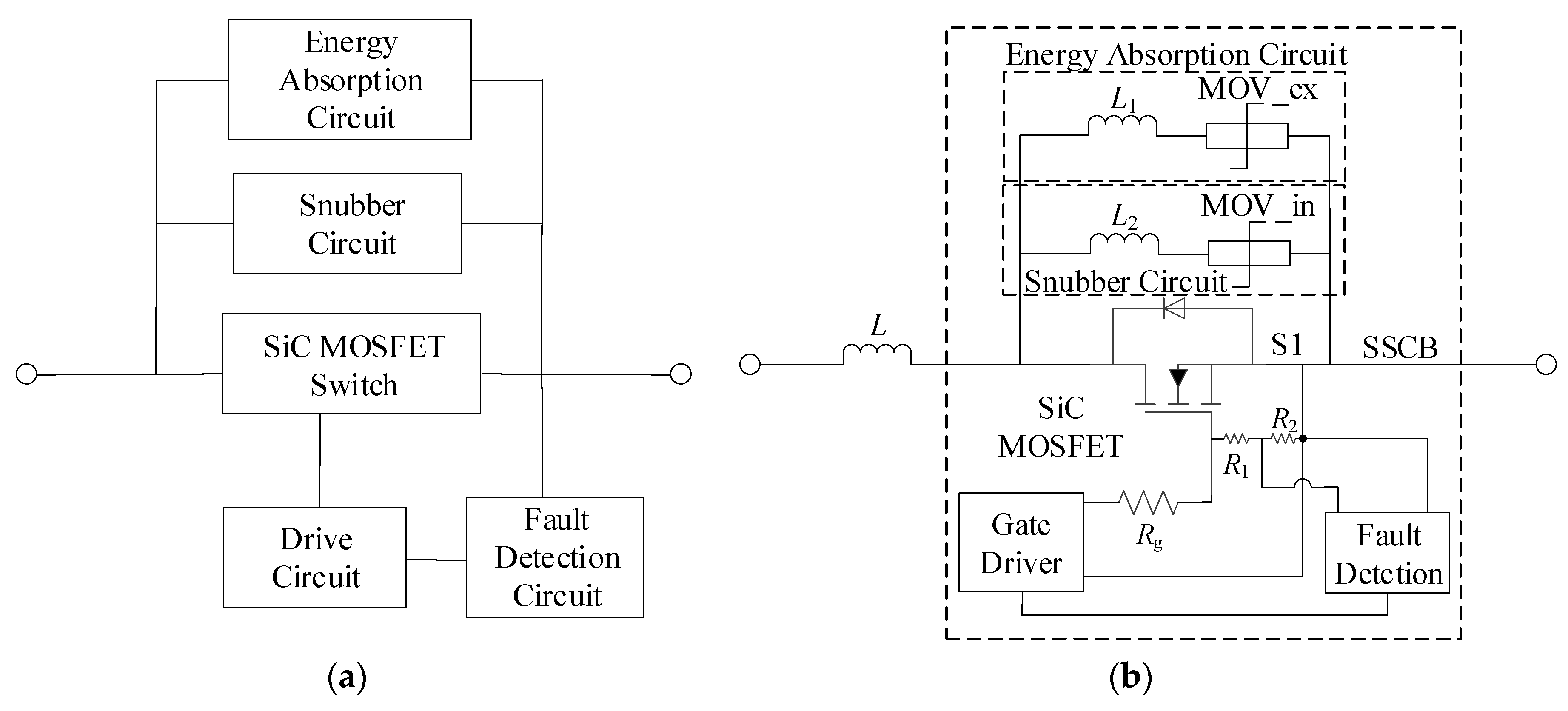

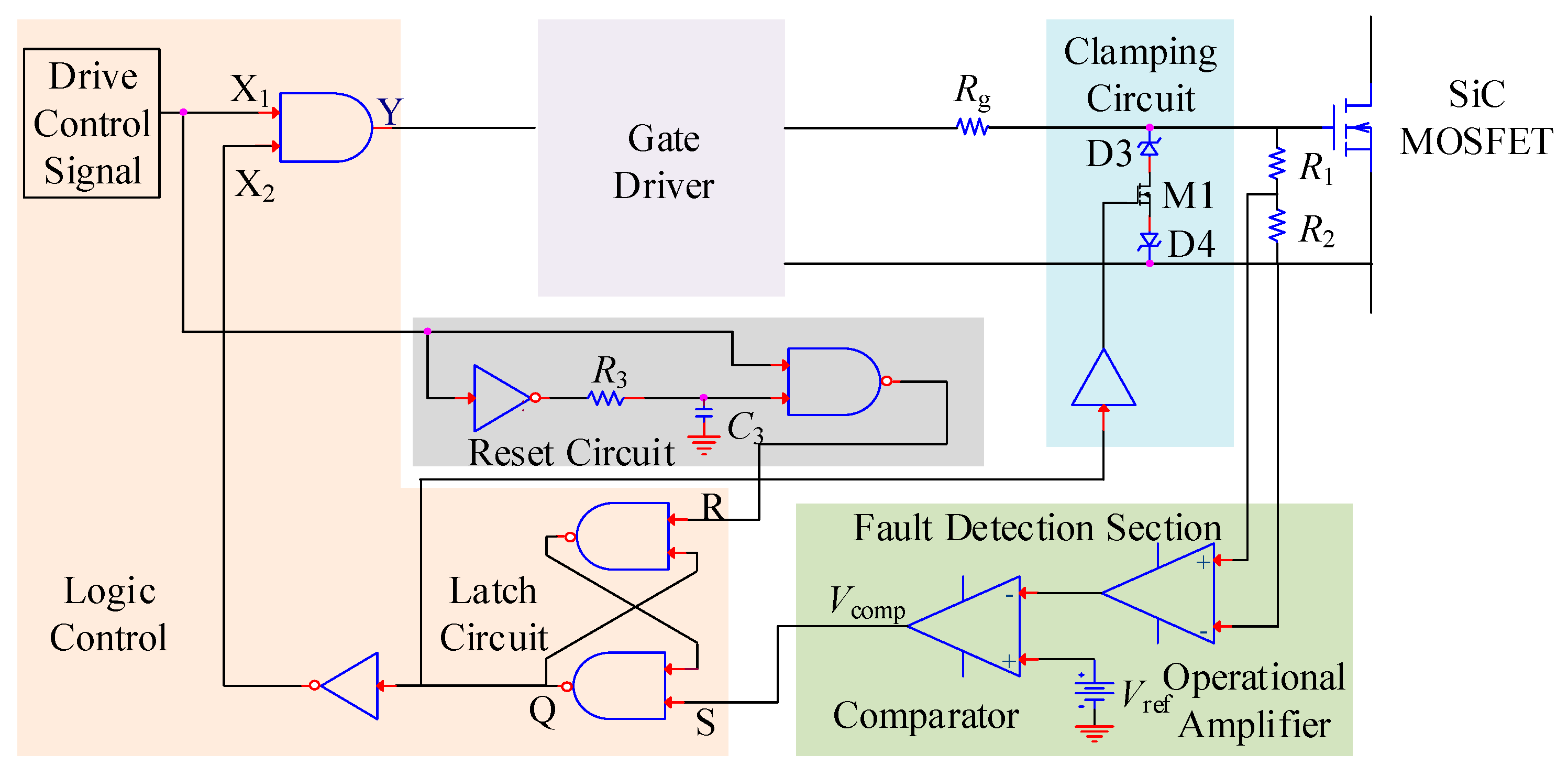
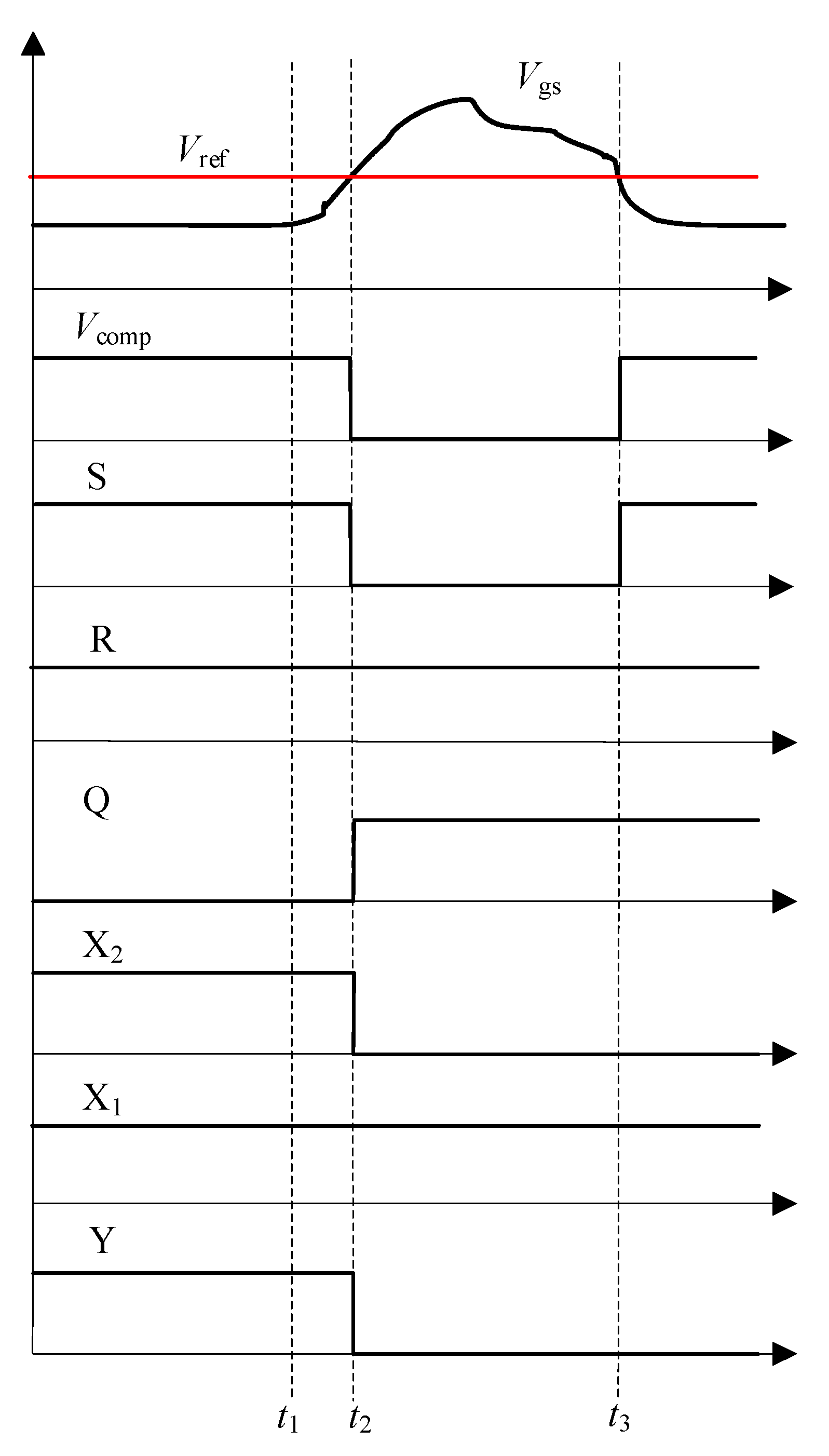
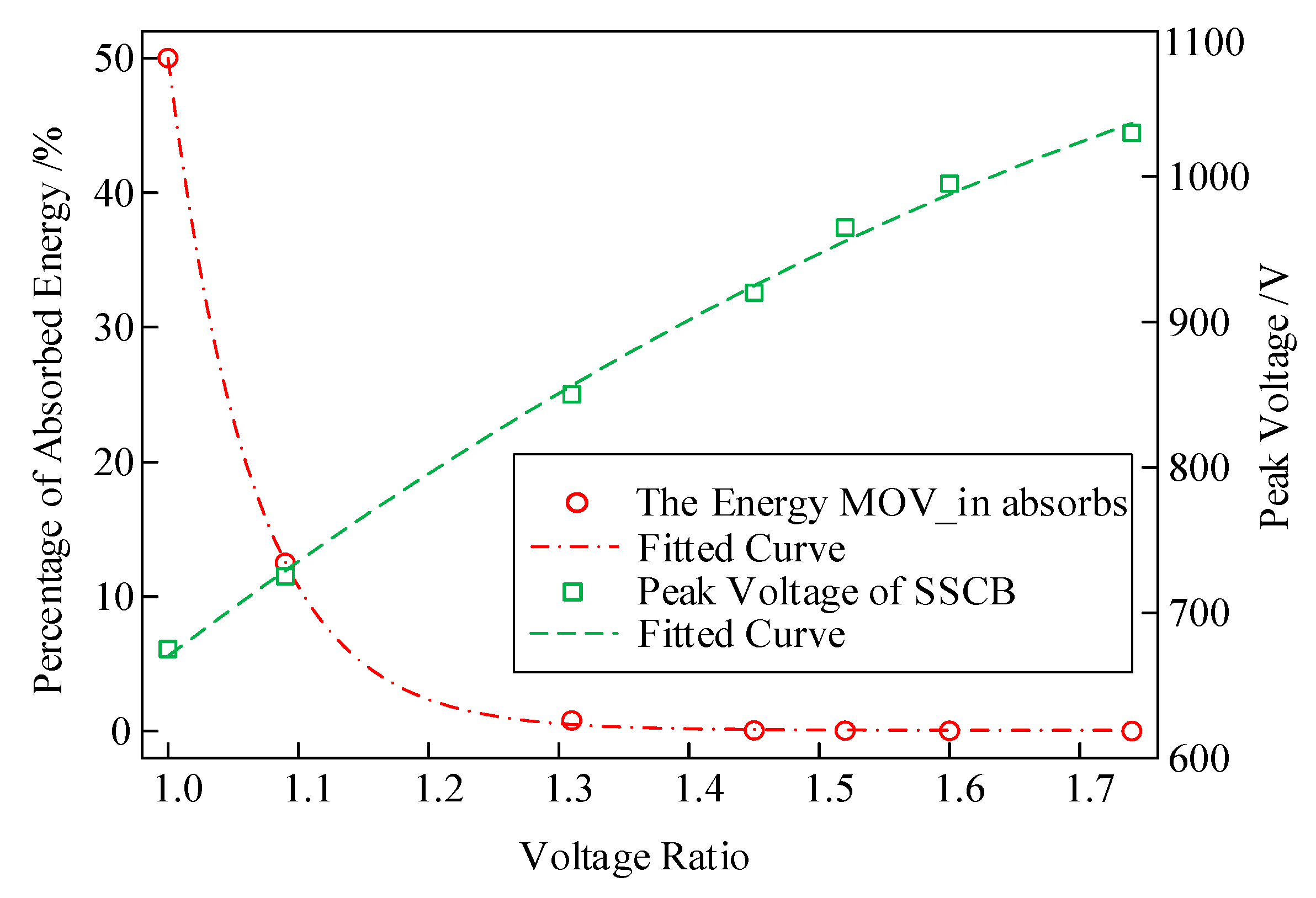
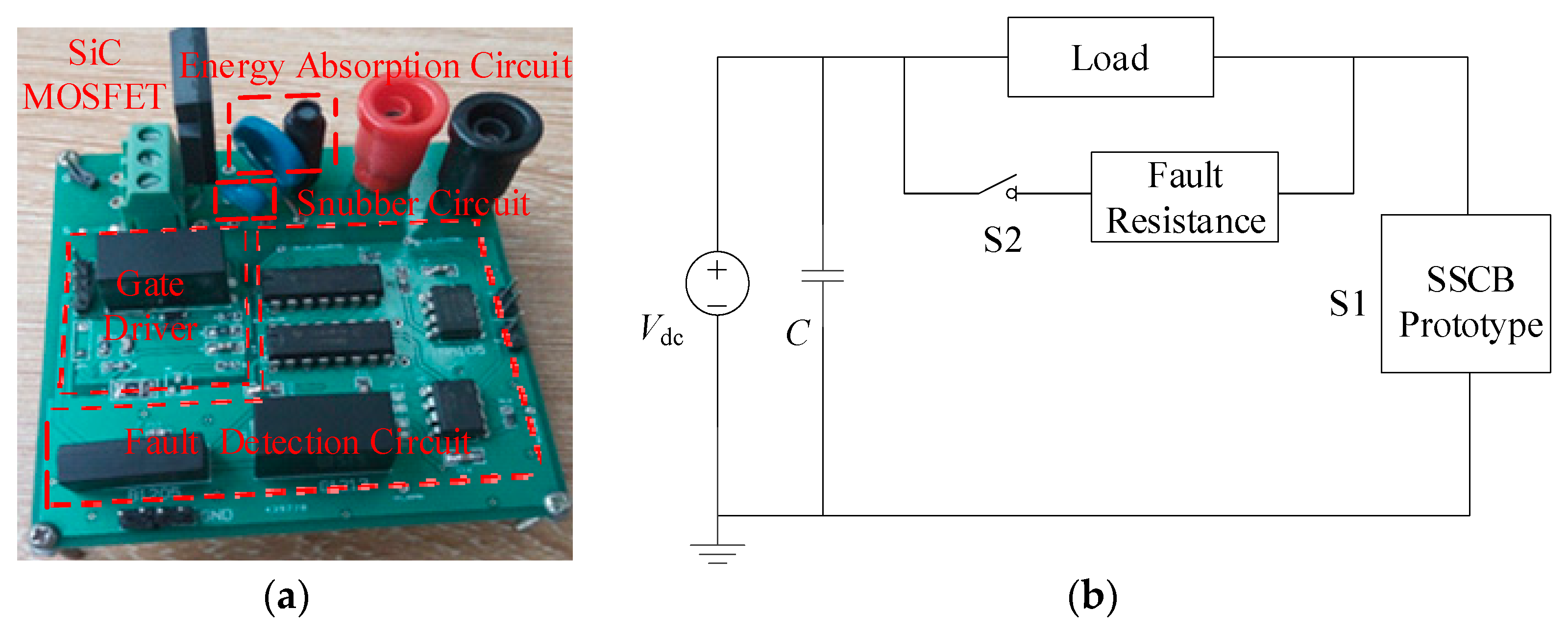


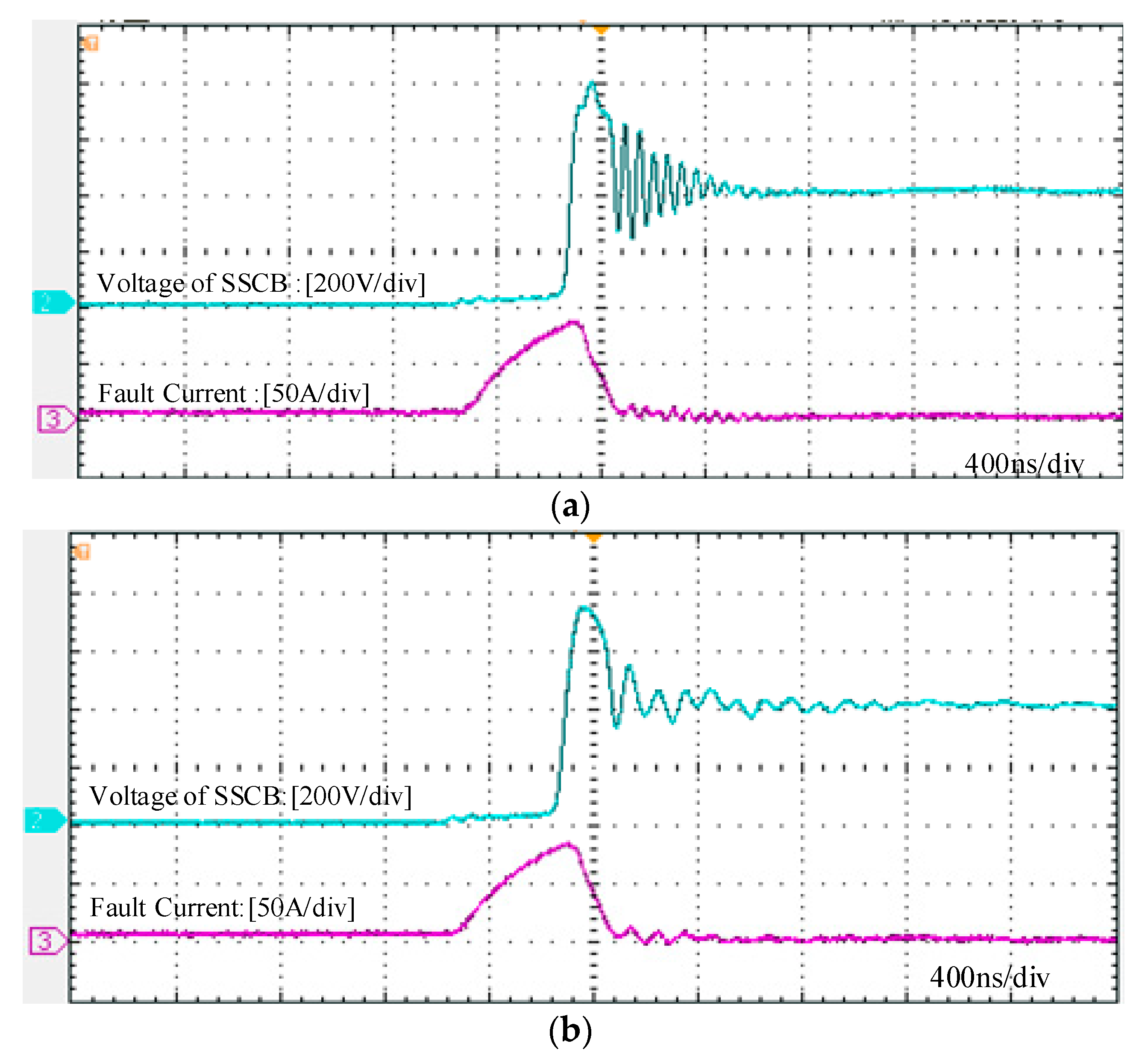

| Parameter | Si | SiC |
|---|---|---|
| Bandgap/eV | 1.1 | 3.2 |
| Thermal Conductivity/(W/(cm·°C)) | 1.3 | 4.6 |
| Electron Velocity/(107 cm/s) | 1 | 3 |
| Device | Temperature = 25 °C, VDC = 600 V | Temperature = 200 °C, VDC = 400 V | ||
|---|---|---|---|---|
| SCWT/μs | Critical Energy/J | SCWT/μs | Critical Energy/J | |
| CREE | 3.5 | 1.2 | 4.7 | 1.3 |
| ROHM | 4.7 | 1.6 | 5 | 1.4 |
| Parameter | Minimal Value | Maximal Value |
|---|---|---|
| Source VCC/V | 10 | 20 |
| Output Current IOUT/A | - | 2.5 |
| Working Temperature T/°C | −40 | 105 |
| Propagation Delay/ns | - | 120 |
| Common Mode Restraining Capability/kV·μs−1 | 50 | - |
| Allowable DC Operating Voltage | Breakdown Voltage | Maximal Clamping Voltage | Maximal Absorbed Energy | Power |
|---|---|---|---|---|
| 415 V | 510 V | 845 V | 125 J | 0.6 W |
| Allowable DC Operating Voltage | Breakdown Voltage | Maximal Clamping Voltage | Maximal Absorbed Energy | Power |
|---|---|---|---|---|
| 560 V | 680 V | 1120 V | 21 J | 0.1 W |
© 2019 by the authors. Licensee MDPI, Basel, Switzerland. This article is an open access article distributed under the terms and conditions of the Creative Commons Attribution (CC BY) license (http://creativecommons.org/licenses/by/4.0/).
Share and Cite
Li, H.; Yu, R.; Zhong, Y.; Yao, R.; Liao, X.; Chen, X. Design of 400 V Miniature DC Solid State Circuit Breaker with SiC MOSFET. Micromachines 2019, 10, 314. https://doi.org/10.3390/mi10050314
Li H, Yu R, Zhong Y, Yao R, Liao X, Chen X. Design of 400 V Miniature DC Solid State Circuit Breaker with SiC MOSFET. Micromachines. 2019; 10(5):314. https://doi.org/10.3390/mi10050314
Chicago/Turabian StyleLi, Hui, Renze Yu, Yi Zhong, Ran Yao, Xinglin Liao, and Xianping Chen. 2019. "Design of 400 V Miniature DC Solid State Circuit Breaker with SiC MOSFET" Micromachines 10, no. 5: 314. https://doi.org/10.3390/mi10050314





